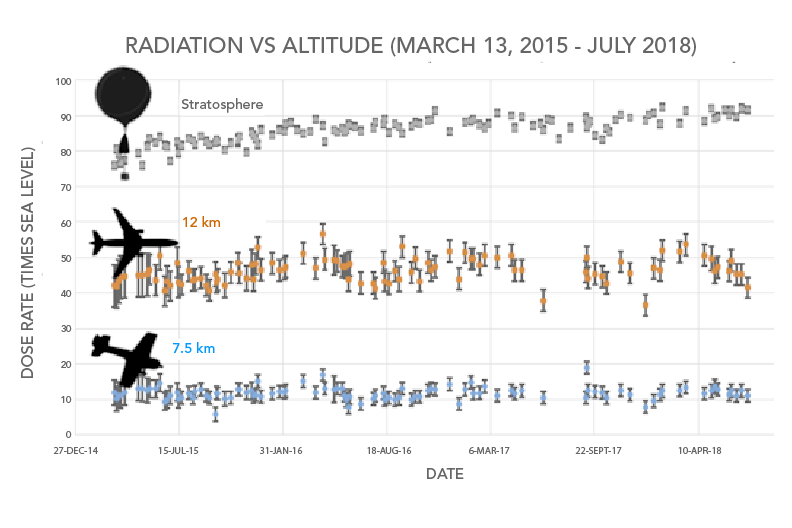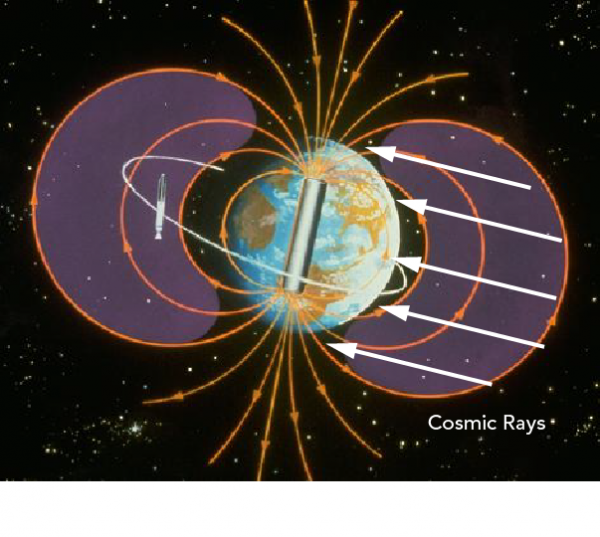BEGINNERS GUIDE TO COSMIC RADIATION

Kim Taylor July 23, 2019
Cosmic Radiation and Aviation
Summary Share on:Learn how people came to understand the source of cosmic radiation, as well as how this radiation impacts those who work in and travel on airplanes.
Cosmic radiation is made up of high-energy particles that come from outer space (the ‘cosmos’). These high-energy particles can cause cancer and other damage to human tissue. Luckily for us, the Earth’s atmosphere and magnetic field protect us from most of these particles.
How was cosmic radiation discovered?
In the early 20th century, scientists were puzzled about the levels of ionizing radiation (high-energy radiation) in the atmosphere. They hypothesized that if the Earth was the source of the radiation, then radiation levels should decrease the further you travel away from the Earth’s surface. Instead, early experiments seemed to show that the amount of radiation increased. This mystery inspired a young Austrian scientist named Victor Francis Hess to look for a way to accurately measure radiation in the atmosphere.
The first thing Hess decided to do was to increase the precision of the measuring equipment. At the time, scientists were beginning to use a new measuring device called an electrometer, which could detect charged particles. By making sure the device was precise, he could be more confident in his measurements.
Next, he needed to get himself and his electrometer up into the atmosphere. He did this using a hot air balloon. Between 1911 and 1913, he went up in the balloon 10 times both in the daytime and at night. He measured the radiation in the atmosphere up to 5.3 kilometres (km) above the Earth.

Hess found that the level of radiation decreased up to an altitude of about 1 km. Altitude is the distance above the Earth’s surface.This is what you would expect if the Earth was the source of the radiation. But at altitudes of more than 1 km, the level of radiation increased. Hess observed that the radiation level at 5 km above the Earth was about twice that of the radiation at sea level.
But what was the source of the radiation? Hess wanted to determine if the radiation was coming from the Sun. He went up in the balloon on the night of a solar eclipse. Even with the moon blocking most of the Sun’s radiation, the radiation level still increased with altitude. This suggested that the radiation was coming from space. Thanks to the discovery of this “cosmic” radiation, Hess shared the Nobel Prize in Physics for 1936.
What is the relationship between radiation and altitude?
As Hess discovered, there is a relationship between altitude and radiation level. The higher you go up, the more radiation you are exposed to. Imagine that you are in a small aircraft flying at an altitude of about 7.5 km (25 000 ft). Your radiation exposure would be about 10 times greater than your exposure at sea level. Now imagine that you are in a larger airplane, the kind you might take to fly to Europe. The typical cruising altitude of commercial jet aircraft like this is around 12 km (40 000 ft). At that altitude, your radiation exposure is about 40 to 50 times greater than your exposure at sea level.

Why is there more radiation exposure at higher altitudes? The main reason is that there is less atmosphere between us and the cosmic rays. The atmosphere protects us. When cosmic rays hit molecules in the air, they split into smaller, less energetic particles. The particles keep on splitting, getting less energetic as they come down to the Earth’s surface. So, without as much atmosphere to protect us, cosmic ray particles can hit us with much more punch!

What is the relationship between radiation and latitude?
Where you fly – your latitude – is also important. Cosmic rays hit the Earth from all directions. But our exposure to them is not equal across the globe. This has to do with our second line of defence against cosmic rays: the Earth’s magnetic field. The Earth’s magnetic field acts as a shield that can deflect some cosmic rays.
Because of the shape of the magnetic field, the shielding works best closest to the equator. There, the rays would hit the atmosphere perpendicular to the magnetic field. In other words, the rays would come in at a right angle.

There is little to no shielding at the north and south poles. There, the incoming rays and the magnetic field run parallel to each other. In fact, cosmic radiation levels in the polar regions are about twice as high as those at the Equator! People who live at the poles are still protected from most cosmic rays by the atmosphere. But people flying above the poles will be exposed to much higher levels of radiation than those flying closer to the Equator.
What is the relationship between radiation and solar activity?
The Earth’s magnetic field is not the only thing that can deflect cosmic rays. Coronal Mass Ejections (CMEs) can also push aside incoming cosmic rays. CMEs are clouds of gases paired with magnetic force fields. They are blown off of the Sun during solar flares. These magnetic fields can repel the electrically-charged cosmic rays that would otherwise hit the Earth. This explains why more cosmic rays reach the Earth during periods of low solar activity.
Did you know?
Solar activity is measured in 11-year cycles. The most recent Solar Maximum, the period when the sun is most active, was in 2014. The Solar Minimum is expected in late 2019 or 2020, so we should expect cosmic radiation levels to increase.

How does cosmic radiation affect airline passengers and crew?
The amount of cosmic radiation you are exposed to while flying depends on four factors. You have already learned about three of them: altitude, latitude, and solar activity. The fourth factor is the duration of the flight. In general, the higher the altitude and latitude and the longer the flight, the greater the radiation exposure.
Did you know?
The health effects of ionizing radiation on the body are measured in millisieverts (mSv).
All people on Earth are exposed in some way to cosmic radiation. But crews on long-distance flights are exposed to much higher levels than the general population. So are passengers who fly often.
In 2001, a study done for Transport Canada found that the highest measured total radiation was on the route from Beijing to Vancouver. The average altitude for this flight was 11.6 km (about 35 000 ft). The total flight time was 10.5 hours (at solar minimum). The total radiation was 0.052 mSv. This is about one hundred times greater than the cosmic radiation exposure experienced at ground level.
Did you know?
The supersonic Concorde airliner, which carried passengers from 1976 to 2003, was the only airliner with a radiation monitoring device among its flight instruments. This was because the Concorde usually flew at 18 km, or 60 000 ft. That is much higher than other airliners!
According to the Centers for Disease Control and Prevention, an airline crew member is exposed to between 0.2 to 5 mSv per year. These levels are similar to, or even exceed, those of radiation workers in nuclear medicine or at nuclear power plants. That is why the International Commission on Radiological Protection (ICRP) considers pilots to be radiation workers!
The ICRP recommends that an aircrew member should be exposed to no more than 100 mSv averaged over 5 years. It also recommends that the general public should be exposed to less than 1 mSv per year. These recommendations were adopted by the Canadian Nuclear Safety Commission (CNSC) in the Nuclear Safety and Control Act, May 31, 2000.
Did you know?
According to the Canadian Radiation Protection Association, a person would get a radiation dose of about 0.03 mSv flying from Toronto to Vancouver, or vice versa.
There are potential health risks from this higher level of radiation exposure. Because of that, national transportation organizations like Transport Canada have made recommendations to help ensure the safety of flight crews. For example:
- Airlines should limit the time their crew spends crew time on:
- very long flights;
- flights at high altitudes; and
- flights that go over the poles.
- Pregnant crew members should not fly during their first trimester.
- Airlines should collect radiation data from flight routes and use it to predict how much radiation crew members on that route will be exposed to.
- Airlines should keep records about the total radiation exposure of crew members.
As of 2016, these remain only recommendations. There are no regulations that force employers to follow these recommendations.
Finally, these recommendations are for flight crews. There are no such safety recommendations for passengers. But some frequent flyers may travel as much as some flight crews.
WHO and WHAT is behind it all ? : >
The bottom line is for the people to regain their original, moral principles, which have intentionally been watered out over the past generations by our press, TV, and other media owned by the Illuminati/Bilderberger Group, corrupting our morals by making misbehavior acceptable to our society. Only in this way shall we conquer this oncoming wave of evil.
Commentary:
Administrator
HUMAN SYNTHESIS
All articles contained in Human-Synthesis are freely available and collected from the Internet. The interpretation of the contents is left to the readers and do not necessarily represent the views of the Administrator. Disclaimer: The contents of this article are of sole responsibility of the author(s). Human-Synthesis will not be responsible for any inaccurate or incorrect statement in this article. Human-Synthesis grants permission to cross-post original Human-Synthesis articles on community internet sites as long as the text & title are not modified.
The source and the author's copyright must be displayed. For publication of Human-Synthesis articles in print or other forms including commercial internet sites. Human-Synthesis contains copyrighted material the use of which has not always been specifically authorized by the copyright owner. We are making such material available to our readers under the provisions of "fair use" in an effort to advance a better understanding of political, economic and social issues. The material on this site is distributed without profit to those who have expressed a prior interest in receiving it for research and educational purposes. If you wish to use copyrighted material for purposes other than "fair use" you must request permission from the copyright owner.